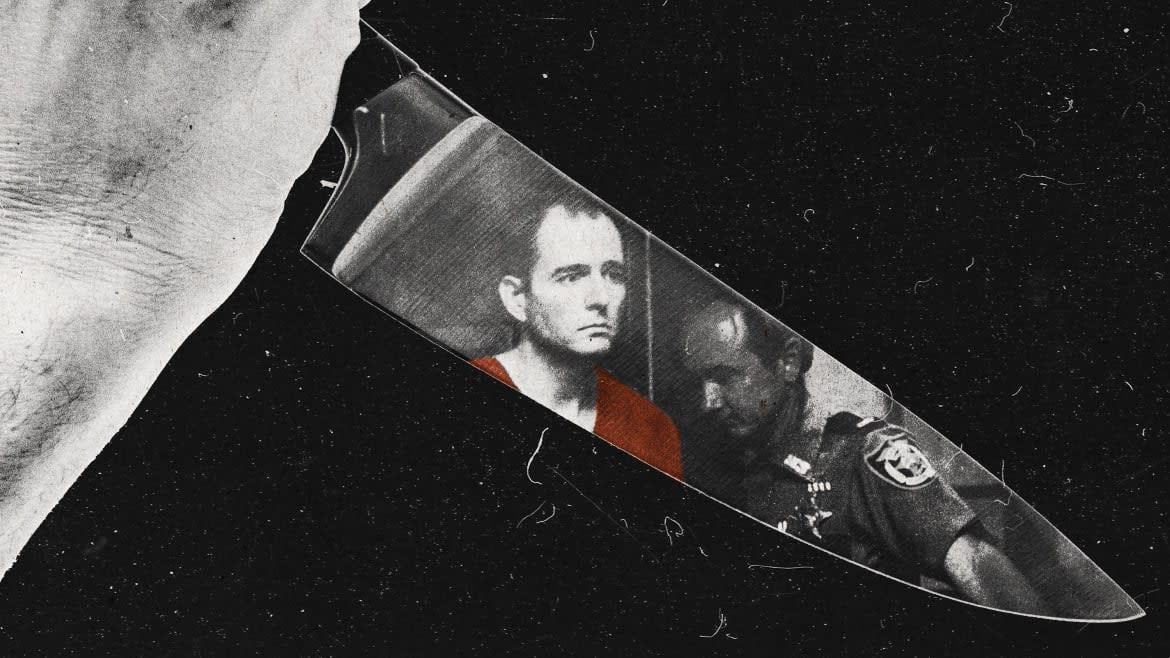The Real-Life Serial Killer Who Inspired the ‘Scream’ Movies

- Oops!Something went wrong.Please try again later.
- Oops!Something went wrong.Please try again later.
American history is filled with trailblazers, from Thomas Edison and Henry Ford to Albert Einstein and the Wright Brothers. According to Discovery+’s “Shock Docs” true-crime series, we should presumably add to that illustrious list paranormal expert Steve Shippy and “world renowned psychic medium” Cindy Kaza, who after conversing with serial killer Ed Gein in this past April’s Ed Gein: The Real Psycho now attempt to chat with another famous fiend who inspired a popular horror movie franchise—Danny Rolling, aka the Gainesville Ripper—in Scream: The True Story (Jan. 14). Armed with a variety of ghost-detecting gizmos and Kaza’s preternatural abilities, they “speak” with the deceased and cleanse haunted abodes of demonic energy, along the way helping both the living and the dead transcend their lingering trauma. They’re pioneers in the field of supernatural investigation—provided, of course, that one believes the abject hokum they’re hawking.
Wes Craven's Favorite Scary Movies
Only the naivest individuals will take Scream: The True Story seriously, given that it’s primarily comprised of scenes in which Shippy and Kaza putz around in the dark, telling each other scary stories about real-life crimes while their electronic spookshow-meter alarms go off and creepy specters answer their questions via a two-way radio box. Shippy and Kaza’s adventures are transparently phony, and there’s something downright unethical about the pair’s eagerness to dupe viewers through the promotion of obvious make-believe. They exploit viewers’ gullibility with calculated lies, and that’s once again true with their latest, which—timed to the same-day theatrical debut of the Scream franchise’s fifth installment—aims to find out if Rolling was telling the truth when he claimed (before his 2006 execution) that he slaughtered eight people between 1989-1990 because he was possessed by a demon named Gemini.
He was not. Nonetheless, despite prosecutor Rod Smith contending, in a new interview, “The Devil made me do it—I never bought any of that. I don’t buy any of that”—Scream: The True Story demands that one maintain an open mind about such a possibility. A burly goateed guy who’s always dressed in black, Shippy (who’s also an indie rapper?) is an “expert” prone to making bold proclamations. Shortly upon arriving at the Gainesville campsite that Rolling stayed at while murdering five college students in August 1990—many of whom he also sexually assaulted and viciously mutilated—Shippy announces, “There’s no doubt that we’re communicating with the spirit of Danny right now.” His evidence is the sound of a voice saying, “I killed people” on one of his bogus devices. In response, Kaza states that this is “totally not what I expected.”
Yes, it is. Shippy and Kaza’s modus operandi involves journeying to locales related to infamous incidents, prowling around with lights and techno-whatsits, and feigning shock, confusion and fear when they inevitably encounter that which they sought—all before fleeing the area once things become just too intense. Scream: The True Story breaks up that action with lame dramatic recreations, drawings made by Rolling and a few initial clips from Wes Craven’s 1996 Scream, as well as some traditional contextual passages featuring footage from Rolling’s trial, TV news stories, and interviews with Smith and Rolling’s former fiancée, Sandra London. Those segments are the only tolerable moments during this two-hour affair, but they’re fleeting, as the show mostly cares about watching its paranormal investigators pretend to confront invisible forces from the other side.
Shippy and Kaza’s main theory isn’t just that Rolling was a puppet of Gemini (the name of the fiend from 1990’s The Exorcist III, by the way), but a victim of either a generational curse or a multigenerational possession that could date back to Rolling’s grandfather (who supposedly decapitated his wife in front of the family) and his father (who was an abusive cop). When Shippy and Kaza hear a voice utter “take…over,” they become convinced that they’re on the right track. Still, with meters blaring all around them, Kaza decides that she doesn’t completely trust this entity. Within minutes, she’s asserting that this is the most manipulative spirit she’s ever worked with, and it’s messing with her thoughts and emotions—declarations that are wholly at odds with her actual on-screen demeanor and behavior, which is as calm and composed as one might expect from a woman delivering a terrible performance.

A memorial graffiti with names of the 1990 murders by serial killer Danny Rolling is seen in Gainesville, Florida, on October 24, 2006.
Once they’ve finished their sleuthing at the campsite, Shippy and Kaza sit down with “Catholic Demonologist” Michael Salerno, who portentously opines, “The greatest thing Satan ever did was convince people that he doesn’t exist. Because if he doesn’t exist, you can’t fight him.” An impressed and newly enlightened Kaza replies, “That is powerful,” thereby proving that she’s never seen The Usual Suspects. Salerno is eventually roped into exorcising the childhood home of Rolling, which is now owned by Sheila Jackson, who recounts underwhelming stories about strange supernatural phenomena taking place in the house. Shippy is particularly fixated on the fact that the Rollings’ original curtains are still hanging on one window, and wouldn’t you know it, that room turns out to be the most disconcerting in the entire abode. Fortunately, though, Salerno’s Latin chanting and burning incense seem to do the trick, begetting a newfound peace that relieves everyone involved.
As in their prior specials, Shippy and Kaza strive to sell their fiction by first talking up their notorious subjects, then suggesting hypotheses about the unholy origins of their evil, and finally manufacturing tension through vague, fake “feelings” and “clues” that validate their hunches. By the conclusion of Scream: The True Story, Gemini is admitting to Shippy and Kaza that he’s a “demon” who’s “in Hell,” while photographs from the duo’s time in the old Rolling house indicate that a black shadow was trying to attach itself to Shippy’s back when he inspected the aforementioned (and now-blood-stained) curtains. That there’s a tidy resolution to this faux-nightmare is as laughable as it is predictable, since Shippy and Kaza’s schtick is not only identifying and interacting with the great beyond, but ridding our earthly plane of the spirits of serial killers who went on to become cinematic icons. What they peddle, however, is about as authentic as a $3 bill.
Get the Daily Beast's biggest scoops and scandals delivered right to your inbox. Sign up now.
Stay informed and gain unlimited access to the Daily Beast's unmatched reporting. Subscribe now.

